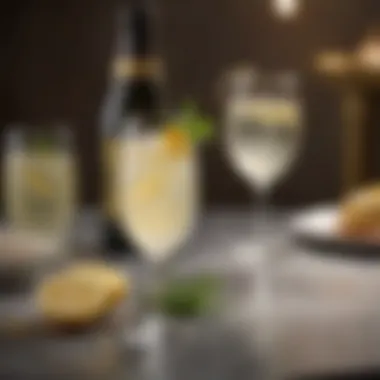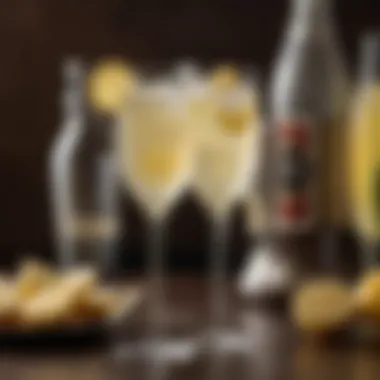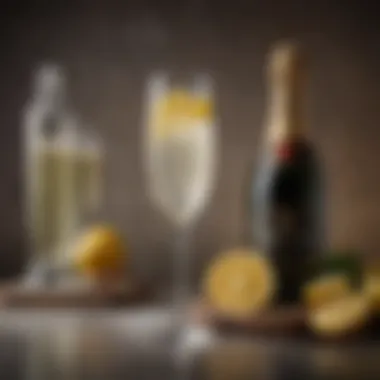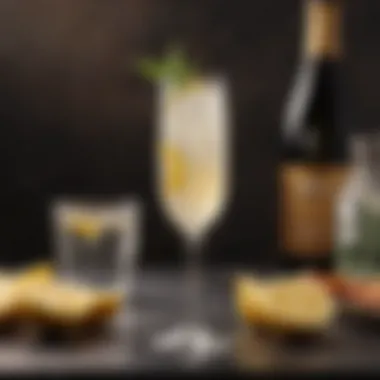The French 75: Discovering a Timeless Cocktail


Intro
The French 75 cocktail has carved a notable niche in the world of mixology, merging the elegance of champagne with the refreshing zest of lemon and a potent kick from gin. This timeless drink not only provides a delightful infusion of flavors but also carries a rich history that reflects both tradition and creativity in cocktail culture.
The origins of the French 75 are often a topic of intrigue. It is believed to date back to World War I, named after the French 75mm field gun, which was known for its power and accuracy. While various stories exist surrounding its invention, what remains constant is its status as a celebratory drink, often associated with special occasions or leisurely gatherings.
As we explore this cocktail, we will touch upon its key components, preparation methods, and the cultural significance that has sustained its popularity through the years. Whether you are an experienced mixologist or simply an enthusiast, this guide aims to deepen your appreciation for the French 75 and perhaps inspire you to craft your own version at home.
Preface to the French
The French 75 cocktail stands as a symbol of elegance and sophistication within the mixology realm. It is not merely a drink; it encapsulates a rich history and a blend of tradition and modernity. Understanding this cocktail's significance offers insights into both its cultural heritage and its relevance in contemporary culinary discourse.
This section serves as an entry point into the world of the French 75, illuminating key aspects that contribute to its status. The cocktail's composition, which includes gin, champagne, lemon juice, and sugar, reflects the intricate balance of flavors that have been celebrated by generations. It is pertinent to note that the French 75 is versatile, easily adaptable to personal tastes while maintaining its core identity.
Moreover, the preparation methods and presentation of the French 75 are vital considerations for any aspiring mixologist. Each choice in crafting this cocktail—from the selection of champagne to the intensity of the lemon's tartness—can lead to a vastly different experience. Its ability to deliver both refreshing and celebratory qualities makes it an ideal choice for a wide array of occasions.
In summary, this introduction highlights the cocktail's importance not only as a celebrated beverage but also as a testament to the artistry inherent in cocktail creation. Exploring the French 75 provides a valuable lens through which readers can appreciate the complexity behind one of mixology's timeless classics.
"The French 75 is not just a drink; it is an experience that reflects the nuances of its cultural background."
As we proceed through this article, we will delve into the historical context, essential ingredients, and preparation techniques that will deepen your appreciation for this distinguished cocktail.
Historical Context
Understanding the historical context of the French 75 provides essential insights into its enduring popularity and multifaceted identity as a cocktail. The narrative behind this beverage is woven through numerous cultural and culinary threads that date back to the origins of the drink itself. Recognizing these elements not only enriches one’s appreciation for the French 75 but also enhances the experience when indulging in this sophisticated concoction. This section will delve into two critical aspects of the French 75's history: its origins and the culinary influences within France.
Origins of the French
The genesis of the French 75 is somewhat shrouded in myth and anecdote. Traditionally, it is believed to have emerged during World War I, attributed to American soldiers who were stationed in France. They reportedly favored a drink that evoked the character and culture of their temporary home, turning to local ingredients for inspiration. One account suggests that the drink was originally known as "Soixante-Quinze," named after the French 75mm artillery gun. It was celebrated for its refreshing nature as well as its potency, drawing parallels between the drink and the artillery piece’s impressive impact on the battlefield.
Documented recipes began to appear in the 1920s, placing gin, lemon juice, and champagne at the forefront. These foundational ingredients would later characterize the drink, combining the depth of spirits with the effervescence of champagne. It is noteworthy that the blending of gin and champagne was revolutionary at a time when cocktails often leaned towards simpler, spirit-forward profiles. This innovation marked the French 75 as not just a drink of the moment but a true pioneer in cocktail culture.
Culinary Influences in France
France's culinary landscape plays a significant role in the charm of the French 75. French cuisine is notorious for its emphasis on quality ingredients and meticulous preparation techniques. A French 75, therefore, mirrors these core principles.
The drink's components — gin, champagne, and fresh lemon juice — reflect the seasonal and regional considerations prevalent in French gastronomy. For instance, the choice of gin, whether it be a London Dry or a more aromatic variant, can showcase local botanicals, while the champagne is always a nod to the prestigious Champagne region, known for its unique terroir and production methods.
Additionally, the cocktail serves as an ideal partner to various French culinary traditions. Pairing a French 75 with light hors d'oeuvres or a charcuterie board elevates the dining experience. It enhances flavors without overshadowing the simplicity and quality of the foods, demonstrating the harmony between drink and cuisine.
Overall, understanding these historical elements gives depth to the French 75, placing it firmly within the greater context of both cocktail evolution and French culinary artistry. This examination of origins and culinary influences provides the groundwork necessary for comprehending its status as a timeless classic.
"The French 75 embodies not only a drink but a celebration of heritage, blending gastronomy with mixology."
The exploration of the French 75’s historical context sets the stage for delving deeper into its ingredients and preparation methods, further enriching one’s knowledge of this remarkable cocktail.
Ingredients Overview


The ingredients used in a cocktail can drastically affect its taste and presentation. The French 75 is no exception. The selection of each component plays a crucial role in creating the perfect balance of flavors. In this section, we will discuss the essential ingredients for the French 75, addressing their individual significance and how they contribute to the overall experience of this classic cocktail.
Base Spirits: Gin and Cognac
The choice of base spirits is vital in defining the character of the French 75. Traditionally, gin is favored for its aromatic qualities and herbal notes. It brings a bright and refreshing element that complements the cocktail's effervescence. Some prefer Cognac for its rich, fruity complexity. Cognac adds layers of depth and sophistication, enhancing the overall flavor profile.
Utilizing either spirit can impact the cocktail’s drinkability. Each selection demands a discerning palate, and the nuances between the two make the potential serving experience much different. A high-quality gin will present juniper and floral notes, while a fine Cognac will imbue the drink with warmth and elegance.
The Role of Champagne
Champagne is an indispensable element in the French 75. Its sparkling nature is not only festive but also essential in providing a light, effervescent quality. The bubbles enhance the sensory experience, while the acidity of the Champagne cuts through the sweetness of the other ingredients. In many instances, it is the Champagne that ties the cocktail together, making it distinctively refreshing.
Choosing the right Champagne can enhance the drink. A brut Champagne works well, as it balances the sugar in the drink. The choice here is pivotal, as the quality of Champagne significantly influences the final product. This ingredient does not just contribute bubbles; it elevates the drink from good to exceptional.
Fresh Lemon Juice and Simple Syrup
Lemon juice serves as a crucial component. Its acidity is essential, cutting through the richness of the spirits and providing brightness. The freshness of lemon juice cannot be overstated; it should always be freshly squeezed for optimal flavor.
In contrast, simple syrup introduces sweetness. This balance between tart and sweet is fundamental in achieving that classic taste of the French 75. Overly sweet drinks can veer into cloying territory, so careful measurements are crucial. Ideally, this mixture should create a harmonious flavor without overpowering the other components.
In summary, each ingredient has specific importance. Choosing your spirits wisely, selecting quality Champagne, and preparing fresh lemon juice and syrup can significantly impact the final cocktail. Understanding these elements allows for a more enjoyable and authentic experience.
"The success of a cocktail often hinges not only on the technique but significantly on the chosen ingredients."
This Ingredients Overview section lays the groundwork for appreciating the complexities and harmonies that define the French 75. It is not merely a drink; it is an assembly of thought-out components that work together to create something timeless.
Preparation Techniques
In crafting the French 75, preparation techniques are critical. These methods not only influence the final taste but also affect the presentation of the cocktail. Mastery of these techniques ensures that the drink maintains its classic essence while allowing for modern interpretations. Each choice in preparation can enhance or diminish the drinking experience.
Shaking vs. Stirring
When making a French 75, the decision to shake or stir has significant implications. Shaking combines the ingredients powerfully, incorporating air and chilling them quickly. This method is often preferred when fresh lemon juice is involved. The aeration helps to create a lighter texture, which complements the effervescence of the Champagne. In contrast, stirring offers a gentler approach, preserving the delicate bubbles of the Champagne. This method can be favored for recipes where clarity and neatness are paramount, especially if using spirits like gin or cognac. Ultimately, the method chosen reflects the desired final product. The texture, temperature, and effervescence all hinge on this fundamental decision.
Proper Glassware
Selecting the right glassware for serving a French 75 is essential for both aesthetics and functionality. Traditionally, a champagne flute is used. Its tall and slim design enhances the visual appeal while allowing bubbles to rise gracefully. Alternatively, coupe glasses can be employed for a vintage approach, though they may not retain the bubbles as effectively. The choice of glass affects the overall drinking experience; for instance, a flute showcases the vibrant drink, inviting enjoyment even before the first sip. Focusing on the glass choice sets the tone for the cocktail and elevates the drinking occasion.
Garnishing Techniques
Garnishes play a pivotal role in the presentation of the French 75. A simple twist of lemon peel provides a touch of aroma and flavor that complements the cocktail's citrus notes. Moreover, a sprig of fresh herbs, such as mint or thyme, can elevate the visual and aromatic qualities. Each garnish should enhance, not overshadow, the cocktail's integrity. This final touch can reflect personal style and creativity. Thoughtful garnishing techniques allow the bartender to personalize the drink while adhering to the timeless quality that defines the French 75.
Classic Recipe for the French
The classic recipe for the French 75 serves as a cornerstone of this distinguished cocktail. Understanding its specific elements is essential for anyone looking to recreate the drink with authenticity. Each ingredient plays a vital role, contributing to the harmonious blend that defines the French 75.
Ingredients and Measurements
To prepare a traditional French 75, you will need the following ingredients:


- 2 ounces of gin (or cognac, depending on preference)
- 1 ounce of freshly squeezed lemon juice
- 1/2 ounce of simple syrup
- 3 ounces of champagne
- Ice
- Lemon twist or cherry for garnish
Using quality ingredients cannot be overstated. Freshness dictates the final flavor, particularly with the lemon juice. Simple syrup can be easily made at home by dissolving equal parts of sugar and water.
Preparation Method
- Combine Ingredients: In a cocktail shaker, combine gin, lemon juice, and simple syrup with ice.
- Shake: Vigorously shake until well chilled.
- Strain: Strain the mixture into a chilled champagne flute.
- Top with Champagne: Carefully add champagne to the glass.
- Garnish: Add a lemon twist or cherry to finish the presentation.
This sequence, while straightforward, reveals an art of balance. Shaking the base ingredients ensures proper mixing and dilution, while the topping with champagne adds effervescence. The garnish enhances both visual appeal and aroma, inviting the drinker to indulge.
Considerations for Optimal Experience
The French 75 is versatile, allowing for personal touches and variations. However, sticking closely to these classic techniques ensures that the integrity of the drink is maintained. Here are some considerations:
- Glassware: Always use a champagne flute or coupe to highlight the drink's elegance.
- Flavor Adjustments: Adjust sugar levels based on personal taste. Some might prefer a touch more sweetness.
In summary, the classic recipe for the French 75 is more than just a list of ingredients. It is a guide that encapsulates a balance of flavors and refined techniques. Through mastery of its preparation, one can appreciate the cocktail's enduring allure in both social and celebratory contexts.
Variations of the French
The French 75 is a cocktail that can enhance any occasion, but its appeal goes beyond its classic recipe. Variations of the French 75 offer mixologists and enthusiasts alike the chance to explore different flavors and experiences. These variations cater to a broader range of palates and celebrate creativity in mixology. They are also essential for home bartenders who want to impress guests or adapt the cocktail to match specific events. By experimenting with unique ingredients, one can create refreshing twists on this timeless drink while still respecting its traditional roots.
The Elderflower Twist
The Elderflower Twist is a popular alternative to the classic French 75. This variation substitutes elderflower liqueur for simple syrup or gin. Elderflower has a gentle floral note that complements the brightness of the lemon juice and the effervescence of Champagne. The addition of this liqueur enhances the drink's aromatic qualities. The Elderflower Twist is excellent for spring and summer events, as it brings a sense of refreshing elegance. To prepare this version, mix:
- 1 ounce of elderflower liqueur
- 1 ounce of fresh lemon juice
- 2 ounces of chilled Champagne
Shake the elderflower liqueur and lemon juice with ice, then strain into a flute. Top with Champagne, and enjoy a delightful floral experience. This version appeals to those who seek a lighter, sweeter cocktail without losing the essence of the original.
The Lavender Infusion
Another intriguing variation is the Lavender Infusion. The soothing aroma of lavender adds a different layer of flavor and complexity. This infusion can be achieved by using lavender syrup in place of regular simple syrup. The cocktail maintains its refreshing quality while introducing herbal notes, making it perfect for evening gatherings or special celebrations. To create this variation, follow these simple steps:
- Mix 1 ounce of lavender syrup
- 1 ounce of fresh lemon juice
- 2 ounces of Champagne
Combine the lavender syrup and lemon juice in a cocktail shaker with ice. Shake well, then strain into a chilled flute. Add the Champagne to finish. Garnishing with a sprig of fresh lavender can elevate the aesthetic appeal, making it not just a drink but also a visual delight.
Non-Alcoholic Version
The allure of the French 75 is not limited just to alcoholic drinks. The Non-Alcoholic Version of the French 75 caters to those who prefer not to indulge in alcohol while still enjoying a sophisticated beverage. This variant maintains the cocktail's essence while offering a delightful mocktail experience. The non-alcoholic French 75 typically includes:
- 2 ounces of tonic water
- 1 ounce of fresh lemon juice
- 1 ounce of simple syrup or fruit-flavored syrup
In this recipe, the tonic water replaces Champagne, providing fizz without alcohol. Mix the lemon juice and simple syrup in a shaker, then fill a glass with ice and top with tonic water. The resulting drink is refreshing and can be garnished with lemon slices or fresh herbs, appealing to all ages. This variation ensures that inclusive celebrations and gatherings can be savored by everyone.
By exploring these variations, one can appreciate the French 75 in diverse forms. Each version offers a different flavor profile while preserving the essential components that make the cocktail special. Through these adaptations, the cocktail continues to evolve, inviting new audiences to discover its charm.
Cultural Significance


The cultural significance of the French 75 extends well beyond its delightful taste. This cocktail is deeply intertwined with celebrations, art, and society. Its ability to capture the essence of moments makes it more than just a drink. This section delves into two prominent aspects that highlight its importance: its presence in literature and film, and its role as a symbol of celebration.
The French in Literature and Film
The French 75 has made notable appearances in various works of literature and film, representing sophistication and indulgence. This cocktail often embodies the spirit of the high life. In literature, authors such as F. Scott Fitzgerald bring the French 75 to life in their narratives, often associating it with the glamour of the Roaring Twenties. It signifies a break from tradition, a nod to the modernist movements of that era.
Moreover, film has continued this trend. Cinema often portrays characters sipping French 75s during pivotal moments, illustrating both romance and adventure. The drink acts as a catalyst for plot development or character relationships. For example, in classic films set in Paris, a French 75 suggests the characters' refined tastes and social status.
This iconic cocktail's representation in these forms of art adds depth to its cultural significance, illustrating how it constructs narratives around enjoyment and leisure.
A Symbol of Celebration
The French 75 also serves as a symbol of celebration across various occasions. Its effervescent nature reflects joy and festivity, making it the go-to choice for toasting significant moments. Whether it's a wedding, New Year’s Eve, or a birthday party, this cocktail enhances the atmosphere of a gathering. The sight of a well-crafted French 75 inspires feelings of festivity and elegance.
"A drink that sparkles as much as the moments it celebrates."
In culinary contexts, it complements various cuisines, enhancing dining experiences. It's often paired with seafood, light appetizers, or desserts, making it versatile across menus. Its refreshing taste works well in both formal and casual settings, reinforcing its status as a celebratory beverage.
These elements contribute to the French 75's allure. It stands not just as a drink; it embodies celebrations, milestones, and shared experiences, reinforcing its timeless appeal in cultural contexts.
Serving the French
Serving the French 75 is not just about pouring a drink; it is an exploration of flavors, aesthetics, and social context that enhances the overall experience. The presentation of the cocktail plays a crucial role in setting the mood, making it important to serve it correctly. This cocktail embodies a union between opulence and simplicity, combining classic ingredients to create a delightful drink. Understanding how to serve it properly can elevate the experience for both the host and guest.
Ideal Pairings with Food
Pairing the French 75 with food can amplify its unique characteristics. The cocktail’s bright acidity and effervescence work well with various cuisine types. Below are some ideal food pairings:
- Seafood Dishes: Fresh oysters or shrimp cocktail amplify the drink's citrus notes.
- Salads: A light salad with vinaigrette complements the French 75’s refreshing properties.
- Cheeses: Soft cheeses like Brie or Camembert can balance the drink's acidity, creating a harmonious flavor.
- Desserts: Citrus-flavored desserts, such as lemon tarts, resonate with the cocktail's lemon juice, enhancing both elements.
When choosing food to serve alongside this drink, keep in mind the balance of flavors. It is wise to avoid overly rich or heavy dishes, as they might overshadow the nuanced taste of the French 75.
Seasonal Serving Suggestions
Seasonality can significantly influence how the French 75 is served, adapting the drink to different occasions throughout the year. Here are some suggestions for each season:
- Spring: Emphasize lightness. Serve with garden salads or fruit-based dishes featuring strawberries or raspberries.
- Summer: Focus on refreshing combinations. Pair with grilled seafood and lighter entrees, taking advantage of al fresco dining.
- Autumn: Consider warming flavors. Accompany with roasted vegetables or pumpkin dishes, integrating spices like cinnamon.
- Winter: Opt for rich and festive offerings. Cheese boards with hearty options, or special holiday desserts enhance the cocktail's warmth.
Incorporating seasonal elements into the serving process makes the French 75 a versatile drink that resonates with various times of the year. By matching it with appropriate food items, the experience is continually interesting and enjoyable.
End
The exploration of the French 75 encapsulates a cocktail that has transcended generations and geographical boundaries. Its blend of gin, cognac, and champagne not only offers a unique taste but also reflects a spectrum of historical contexts and cultural significance. This timeless drink interweaves tradition and modernity, showcasing how a simple mix of ingredients can evolve into a symbol of celebration and sophistication.
The Enduring Appeal of the French
The French 75 stands out for several reasons. Its versatility appeals to diverse palates. The base spirits can be adjusted based on preference. This adaptability is essential for both home mixologists and professional bartenders. The sparkling aspect from champagne or sparkling wine adds an element of festivity.
Moreover, the cocktail’s rich history enhances its allure. Understanding its origins, ranging from its likely conception during World War I to its modern interpretations, adds depth to the drinking experience. The French 75 serves not just as a beverage but as a story in a glass, inviting drinkers to participate in this lineage.
Additionally, the aesthetic presentation of a beautifully crafted French 75 is noteworthy. Served typically in a flute or coupe glass, garnished with a lemon twist, it speaks to an elegance that suits various occasions—from casual gatherings to formal celebrations. It becomes part of the setting, igniting a sense of sophistication.
"A cocktail crafted with care isn't just about what’s in the glass; it’s about the moments it creates and the memories shared."
In summary, the enduring appeal of the French 75 lies in its blend of historical significance, culinary versatility, and aesthetic charm. These elements make the cocktail not only a drink but a cultural artifact, relevant in social settings from the past and continuing into the present. This duality of function and form reinforces the French 75's status as a celebrated cocktail, ensuring its position in the world of mixology for years to come.















